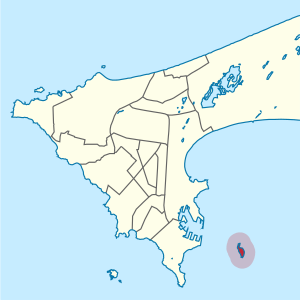Gorée
|
Gorée Sor |
|
|---|---|
| Commune d'arrondissement | |
 Gorée location |
|
| Country |
|
| Region | Dakar Region |
| Department | Dakar Department |
| Area | |
| • Total | 0.5 km2 (0.2 sq mi) |
| Population (2013) | |
| • Total | 1,680 |
| • Density | 3,400/km2 (8,700/sq mi) |
| Time zone | GMT (UTC+0) |
| Island of Gorée | |
|---|---|
| Name as inscribed on the World Heritage List | |
 |
|
| Location | Senegal |
| Type | Historical/Cultural |
| Criteria | vi |
| Reference | 26 |
| UNESCO region | Africa |
| Inscription history | |
| Inscription | 1978 (2nd Session) |
Coordinates: 14°40′01″N 17°23′54″W / 14.66694°N 17.39833°W
Île de Gorée (i.e. "Gorée Island"; (French pronunciation: [ildəɡoʁe], from Dutch Goede Reede (good harbor)) is one of the 19 communes d'arrondissement (i.e. districts) of the city of Dakar, Senegal. It is an 18.2-hectare (45-acre) island located 2 kilometres (1.1 nmi; 1.2 mi) at sea from the main harbor of Dakar (14°40′0″N 17°24′0″W / 14.66667°N 17.40000°W).
Its population as of the 2013 census was 1,680 inhabitants, giving a density of 5,802 inhabitants per square kilometre (15,030/sq mi), which is only half the average density of the city of Dakar. Gorée is both the smallest and the least populated of the 19 communes d'arrondissement of Dakar.
Gorée is famous as a destination for people interested in the Atlantic slave trade. Other important centres for the slave trade from Senegal were further north, at Saint-Louis, Senegal, or to the south in the Gambia, at the mouths of major rivers for trade. It is a UNESCO World Heritage Site.
...
Wikipedia
